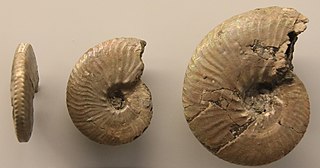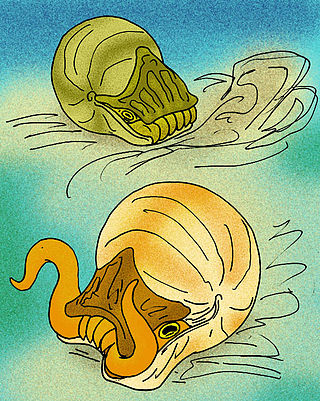Related Research Articles

Anahoplites is a genus of rather involute, compressed hoplitid ammonites with flat sides, narrow flat or grooved venters, and flexious ribs or striae arising from weak umbilicle tubercles that end in fine dense ventrolateral nodes. The elements of their sutures are short, wide and jaggedy. Specimens of Annahoplites have diameters typically in the range of 4–6 centimetres (1.6–2.4 in) although some with diameters of as much as 19 centimetres (7.5 in) have been reported. The genus lived during the Cretaceous, from the Middle to the late Albian.

Aulacostephanus is an extinct ammonoid cephalopod genus from the Upper Jurassic Tithonian belonging to the perisphinctoidean family Aulacostephanidae.

Aspidoceras is an extinct ammonoid cephalopod genus belonging to the family Aspidoceratidae.

Arcestes is a genus of extinct ceratitid ammonites found in Triassic-aged marine strata.

Hoplites is a genus of ammonite that lived from the Early Albian to the beginning of the Middle Albian. Its fossils have been found in Europe, Transcaspia and Mexico. Shell has compressed, rectangular till depressed and trapezoidal whorl section. There are strong umbilical bullae from which, prominent ribs are branching and these are interrupted on venter. Ends of ribs on the venter are prominent and can be both alternate or opposite. Some species have zigzagging ribs and these ribs ends usually thickened, or they can be raised into ventrolateral tubercles. These tubercles are mostly oblique clavi.
Ussurites is an extinct ammonoid cephalopod genus belonging to the suborder Phylloceratina and is included in the family Ussuritidae. Its range is restricted to the early Middle Triassic, (Anisian)
Homaloceras is an extinct nautiloid cephalopod from the Middle Devonian with a strongly curved shell, included in the nautilid family Centroceratidae.
Permonautilus is an extinct genus of nautilids from the Upper Permian of Russia, named and described by Kruglov in 1933. Permonautilus is an involute, globular, spinose member of the Lirocertidae which are included in the Clydonautilaceae. Whorl sections are broad, with a rounded venter. The umbilicus in the middle of the shell is deep, from which spine-like processes extend laterally in the mature portion near the aperture. The siphuncle in Permonautilus is subcentral, the suture, slightly sinuous.
Aphelaeceras is an extinct genus from the nautilid family Trigonoceratidae which is part of the Trigonocerataceae, that lived during the Mississippian Period in the late Paleozoic.

Macrocephalites is a genus of the stephanoceratoid ammonite family Macrocephalitidae, diagnostic of the Callovian stage of the Middle Jurassic. Three subgenera, Dolikephalites, Kamptokephalites, and Pleurocephalites are recognized in addition to Macrocephalites itself, with Indocephalites tentatively included as the fourth.
Neolissoceras is a genus of haploceratid ammonites with a smooth, compressed, flat-sided shell with a flatly rounded venter and distinct umbilical margin, from the Upper Jurassic (Tithonian) - Lower Cretaceous (Hauterivian) of southern Europe, Madagascar, and India.

Kepplerites is a moderately evolute ammonite from the lower Callovian included in the Stephanoceratoidea.
Distichoceras is a member of the Haploceratacean family, Oppeliidae, and type genus for the subfamily Distichoceratinae, found in upper Middle and lower Upper Jurassic sediments in Europe, Algeria, India, and Madagascar. The shell is essentially evolute and compressed with the outer flanks converging on a narrow, keeled venter; inner flanks which may be feebly ribbed, are separated from outer by a shallow spiral groove or band. Ribs on outer flanks end on or are looped to tall clavi that line the venter, standing above the keel.

Hauericeras is an ammonite genus from the Late Cretaceous that lived from the Coniacian to the late Maastrichtian, from about 90 to 66 mya. Fossils have been found in Europe, Russia, South Africa, Australia, India, Iraq, and in the United States.

Neocomites is a genus of ammonite from the Lower Cretaceous, Berriasian to Hauterivian, and type genus for the Neocomitidae.
Pseudohaploceras is a genus of desmosceratid ammonites from the Early Cretaceous; Valanginian to Albian epochs.

Ophiceras is a genus of smooth, evolute ceratitid ammonites from the Early Triassic, with a rounded venter. Fossils of the genus have been found in Armenia, Azerbaijan, China, Greenland, and India.
Euomphaloceras is an early Upper Cretaceous ammonite genus,, included in the Acanthoceratinae until established as the type genus for the Euomphaloceratinae by Cooper, 1978.
Ochetoceras is a genus of ammonites, belonging to the Oppeliidae, that lived during the Late Jurassic from the early Oxfordian to the early Tithonian, and type for the subfamily Ochetoceratinae.
Beecheria is an extinct genus of brachiopod belonging to the order Terebratulida and family Beecheriidae. Fossils of this genus have been found in Mississippian to Permian beds in Eurasia, Australia, North America, and South America. The genus was part of the Levipustula fauna characteristic of cold water conditions. "Nests" of Beecheria have been found in fossil low temperature hydrothermal vent communities from the early Carboniferous in Newfoundland.
References
- 1 2 Sepkoski, Jack (2002). "A compendium of fossil marine animal genera (Cephalopoda entry)". Bulletins of American Paleontology. 363: 1–560. Archived from the original on 2008-05-07. Retrieved 2017-10-18.
- Treatise on Invertebrate Paleontology, Part L Ammonoidea (L309); Geological Society of America and Univ of Kansas press, 5th printing, 1990